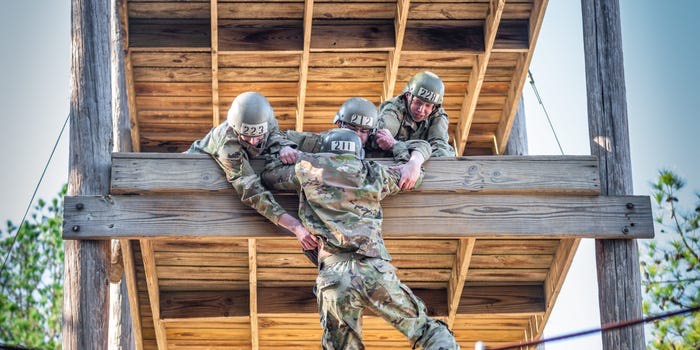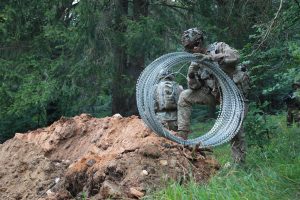Stop the Reading Lists: Why Leaders Need More Than Just Books

If I had a nickel for every time a superior officer told me, “Leaders are Readers,” I would probably have enough money to buy lunch at the DFAC. But here is my hot take: leaders AREN’T just readers—leaders are THINKERS!
In an age where information is just a click away, I often wonder why we remain so fixated on reading as the ultimate leadership development tool. The phrase “leaders are readers” implies that leadership growth hinges on reading alone. However, leadership is a multifaceted skill, nurtured through various outlets that cater to diverse learning styles and preferences. By promoting reading as the only path, we overlook a wealth of other methods that develop emotional intelligence, decision-making, and personal growth.
Let me be the first to say I am a pseudo-reader. As a kid and a teenager, I devoured books. However, once I went to college, reading became more difficult. And just when I thought I was free from the clutches of mandated books and articles, I was commissioned as a Field Artillery Officer. I was a dutiful officer, though; every time a mentor recommended a book that would:
“Absolutely change the way you think as a leader.”
“Make an impact on you as a leader to better your soldiers.”
“…it made a difference in my career, so it will do the same for you.”
I would order said book from Amazon, get through about 37 pages before I lose steam, and give it a home with 150 of its closest relatives on my industrial bookshelf. It begged the question…does this make me a bad leader? It only took me 11 years, but I am here to tell you: absolutely not. You can grow as a leader and learn to inspire others through many methods, not just reading.
The number of books you read in the last year does not certify you in the school of officership, nor is it guaranteed that anyone who reads the entirety of some colonel’s outdated reading list will automatically turn into Sam Damon (in a case of irony, if you don’t know who this is, he’s an aspiring character in the novel Once an Eagle). Any action taken with the intent of growing as a leader is futile unless one deliberately thinks, reflects, and applies their takeaways to their leadership philosophy. How you receive and process information will dictate how you consume inspiration. Thus, “reading lists” are an exclusive form of developing leaders. While reading is A tool, it’s not the only tool, and I would challenge leaders who perpetuate “leaders are readers” to change their mantra.
Thinkers, Not Just Readers
Let’s briefly cover some evidence to affirm my bid to dismantle the long-standing system. Howard Garner’s “Multiple Intelligences Theory” posits that individuals excel in their own unique form of intelligence, meaning that each of us learns and grows in different ways. The exceptional leader or manager who can understand their team’s capabilities optimizes team cohesion, individual growth, and the leader’s own personal skills. In a different approach, Kolb’s Experiential Learning Theory argues leadership development occurs through a cycle of concrete experience, reflective observation, abstract conceptualization, and active experimentation. This theory, deeply rooted in the individuals’ experiences and a leader who guides them through the reflection on said experience, requires a much more “hands-on” approach than a passive reading list. If we could get each of our subordinates to THINK more, realize their own potential, or connect the dots on how a concrete event led them to personal growth, we might have a little more faith in our leaders.
However, reading my words and actively practicing it are two different things, and before we guide our subordinates through the art of thinking, we need to ensure we embrace it and lead by example. I can empathize with how difficult it is to prioritize time for reflection, much less making time to write about it or make a deliberate plan to apply your thoughts to personal growth. But it is your responsibility as a leader to prioritize your time in order to foster your own growth. The Army and its myriad of meetings will go rolling along, but if you don’t take the time to invest in yourself, you will be stagnant. To put it bluntly, true leaders are not stagnant – they are growth mindset people who inspire the same in others.
So, to leaders young and old, please believe that leadership cultivation cannot be confined to the pages of a book. While reading is a valuable tool, it is one of many ways to develop the skills and mindset needed to lead effectively. By embracing diverse learning methods—listening, reflecting, experiencing, and engaging with others—we can ensure that leadership development is inclusive, dynamic, and tailored to the needs of all leaders.
Practice Makes Progress: Developing The Way You Think
If you’re still reading, I’ll take it as a sign that I’ve converted you, or at least piqued your interest, to further explore the other diverse learning methods I’ve hinted at throughout this article. Please indulge me as l share my TTPs for practicing “Leaders are Thinkers”.
- Start with curating your own “Thinking Toolbox”: This is a collection of diverse resources that have influenced the way you see the world, have inspired an aspect of your leadership philosophy, or optimize your lifestyle. Be sure to include what resonates with your learning style (podcasts, films, articles, books, mentors, etc).
- Set intentional time for reflection: This is the hardest step, because it takes a deliberate planning effort to block time in your day where you can just think: no distractions, no TikTok, no nada. Over the years, I find that the time I set aside ebbs and flows, depending on the demands of my job. Currently, it’s a part of my nighttime routine to reflect on my day and write down some points of gratitude. If something especially sticks out from my day that I want to further reflect on or journal, I will write it down on my bedside notecards and the next morning, I will make a plan to block time in my planner for that specific reflection. Also, I will try to program journaling or writing time on the weekends. Mornings work best for me, and I usually do it in a quiet place with a hot cup of coffee. Remember, sometimes reflection comes to you, outside of your scheduled time to think. Your mind will be wrapped around something that you’re trying to unravel, and until you shift your schedule to make time to think, it will be there in the back of your mind. Do your best to adjust your schedule so you can sort through what’s on your mind and heart – suppressing it could result in anxiety and other undetected issues. Making time to think is a challenge, but the reward is high.
- Engage, Seek, Apply: While personal reflection is a resource to explore your own thoughts and perspectives, one’s horizons can be broadened through engaging in quality conversations. Ask mentors, peers, or your team of subordinates thought-provoking questions to challenge your own thinking and encourage growth in others. I especially like this approach because if the conversation dives into deep discussions, it (should) appeal to introverts and extroverts alike. Seek feedback from those you work with about your leadership and decision-making style. Share their perspectives with mentors or journal their feedback to better understand how to improve as a leader. Both “engaging” and “seeking” are great ways to develop your leadership style, but are only as good as your application of those reflections.
- Be consistent and update often: Speaking from personal experience, it can seem tedious to continuously update one’s Thinking Toolbox, but it is necessary. Consistent reflection and feedback will identify gaps and trends in your growth, and through engaging conversation and your own curiosity, you can find resources to address your needs. Periodically review and update your Thinking Toolbox based on your recent growth to keep your learning dynamic. When you update your Leadership Lab, save the old copy and include the date and jobs you held throughout that list. You can see what has influenced you over time and potentially share a specific Thinking Toolbox with someone in a similar job or environment.
- The Company You Keep: Underastanding your environment and how it affects you will directly influence your mindset, motivation, and personal growth. The Army gifts us with the unique opportunity of mandated environments: we don’t get to choose our peers, our subordinates, or our superiors. Sometimes we strike gold and are in a positive environment surrounded by inspirational professionals who value personal growth. Other times we are challenged with being a part of a negative environment filled with complacency and complainers. In the latter, you still have an opportunity to reflect and grow, and more so, you have the responsibility to lead by example and be the positive force in that environment. Your resilience will be tested, your empathy will be challenged, but your growth will be exponential. In either instance, one truth still remains: YOU get to choose your environment outside of the workplace, and there is power in this. Motivational speaker Jim Rohn wrote, “You are the average of the five people you spend the most time with.” So, take a moment to think, “who am I?”
Conclusion: Thinking Beyond the Basics
I sincerely believe that transformational leadership is a skill that resides in each of us, and it is up to the individual leader whether that skill is applied or remains dormant. Our unknown potential comes to fruition when we challenge ourselves to think deeply, reflect honestly, and seek inspiration from diverse sources. Whether it’s through the conversations we engage in, the habits we cultivate, or the environments we create, leadership is as much about intentionality as it is about action.
As leaders, we owe it to ourselves and those we serve to embrace a growth mindset, to constantly reassess and refine our approaches, and to build our own unique frameworks for learning and thinking. Once you start consistently thinking, reflecting, and building your toolbox, it gets easier to continue. Life will happen, and your routine will get interrupted, so give yourself grace if you miss some opportunities for deep thinking. This journey is neither linear nor simple, but it is deeply rewarding—and it begins with taking deliberate steps to invest in ourselves.
With that in mind, I’m excited to share my personal “Thinking Toolbox.” I hope it inspires you to build your own collection of resources, tailored to your journey as a leader and thinker.
Happy Thinking!
Author Biography
MAJ Sara Roger is a Field Artillery Officer currently serving as the Brigade Fire Support Officer for the 41st Field Artillery Brigade. She enjoys living life to the fullest with her best friend and husband, MAJ Sam Balch (also a Field Artillery Officer).
Related Posts

4 Essential Behaviors for Building Trust
Sincerity. Reliability. Competence. Care. No matter your role as a company-grade officer, trust is foundational to a team’s success. Trust connects a leader’s intent to …

Going Off Script, But Staying on Track: A Career Guide for Junior Leaders
Intro I walked into LTC Tomi King’s office as a new 2LT in his formation. We discussed all the normal talking points in that initial counseling – family, where I …

Fighting as an Enabler Leader
(U.S. Army Photo by Cpl. Tomarius Roberts, courtesy of DVIDS)Enablers provide capabilities to commanders that they either do not have on their own or do not have in sufficient quantity …
